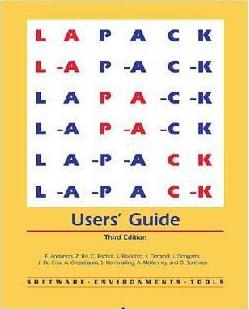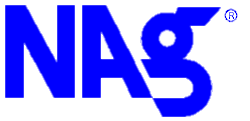 |
 |
 |
 |
The NAG Fortran Library is a comprehensive mathematical
and statistical software library. In addition to
numerical
linear algebra, it contains mathematical software for root
finding
and nonlinear systems, Fast Fourier Transforms, quadrature, ordinary
and
partial differential equations, interpolation, curve and surface
fitting,
and optimization. It also contains statistical software,
including
regression analysis, multivariate statistical analysis, analysis of
variance,
nonparametric statistics, contingency tables, and time series.
The
NAG
Library
is a commercial package, developed by the Numerical
Algorithms Group. A very old version (Mark 14,
1990) is installed on some machines on our network.
Current
releases of the NAG software
library are available (for legitimate educational and/or research use)
through the Ohio Supercomputer Center's (OSC)
"Statewide Software License" program. A
portion of the NAG Library is
also accessible from inside the Maple
computer algebra system, which also is installed on our network.
For information on accessing Maple
on our network, see here.
Compiled library archives, for both LAPACK and NAG, are installed on the main servers on our Math/CS network:
% cc -c lapack_driver.c
% f90 lapack_driver.o -L/local/opt/fortran/lib -llapack -lblas
% CC -L/local/opt/fortran/lib -L/opt/fortran/lib lapack_driver.cpp -llapack -lblas
% f90 nag_driver.f -L/local/opt/fortran/lib -lnag
% cc -c nag_driver.c
% f90 nag_driver.o -L/local/opt/fortran/lib -lnag
% CC -L/local/opt/fortran/lib nag_driver.cpp -lnag
% cc -c lapack_driver.c
% f77 lapack_driver.o -llapack
% c++ -c lapack_driver.cpp
% f77 lapack_driver.o -llapack -lstdc++
% c++ lapack_driver.cpp -llapack -lg2c
% f77 nag_driver.f -lnag
% f77 nag_driver.f /vol/nag/lib/linux/libnag.a
% cc -c nag_driver.c
% f77 nag_driver.o -lnag
% cc -c nag_driver.c
% f77 nag_driver.o /vol/nag/lib/linux/libnag.a
In calling Fortran programs from C programs, one needs to take into account certain differences between the two languages, in particular, all input and/or output arguments in Fortran are passed by reference, and arrays in Fortran are stored in column-major order (whereas C stores arrays in row-major order). Aspects of dealing with these differences are indicated in the test/example programs above.
For LAPACK, instead of using the pre-compiled libraries (as described above), one can also download (from the LAPACK subdirectory at Netlib) the Fortran source code for the routines you need to use and simply compile them together with your driver routine. Since most of the LAPACK routines also call other (lower-level or auxiliary) routines, you should to be sure to click to download the routines "plus dependenices."
% man lapackfor general information.
Other examples:
% man ddotto obtain information (calling sequence, input/output argument list) for the BLAS routine to calculate the real double-precision dot product of two vectors, or
% man cgesvfor the LAPACK routine to solve a general complex single-precision system of linear equations.
The LAPACK man pages on the HP machines are locally
installed.
For the man utility to find them, their location must be
properly
incorporated into the MANPATH
environment variable.
This should happen automatically if your .cshrc or .login
(or .bashrc or .bash_profile or ... ) script
sources in the file /etc/MANPATH. Alternately,
or
if you have problems, you can add the directory manually (or in your .cshrc
or .login or ... file) via (csh/tcsh syntax)
The most complete information on the LAPACK Library is contained in the LAPACK Users' Guide, 3rd Edition, which is available in hard copy (from SIAM Publications--you can probably borrow a copy from one of the numerical analysts in our department) or in on-line version (at the link above).
There are no on-line man pages for the NAG Library.
Usage
notes can be found in the subdirectory /vol/nag/doc/ (see in
particular
the "Essential Introduction" essint and the "User's Note" un).
An extensive collection of examples is in /vol/nag/examples/.
The most complete documentation consists of the multi-volume hard-copy
set in our Documentation Room: room 313A, the last side
room
in the Math/CS Library. The library/mailroom key (which
is
issued to all Math/CS faculty and graduate students) will open this
room.
If you do not have one of these keys, then you will need to see a
secretary
in the Math/CS Main Office (room 233) to borrow
one.
The best place to start is the spiral-bound NAG Fortran Library
Introductory
Guide - Mark 14, which you can also borrow from one of the
numerical analysts.